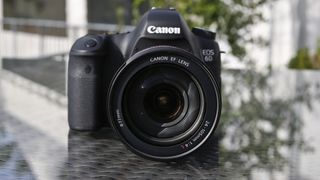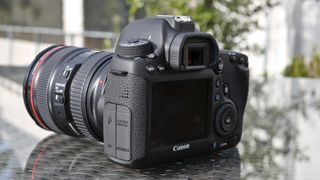Why you can trust TechRadar
With 11 AF points grouped around the centre of the frame, there is a fair amount of choice, but only the centre one is cross type. We found that although the Canon 6D can focus quickly when the peripheral points are used, it doesn't track moving subjects quite so well as when the centre point is used.
When photographing deer, we had a near 100% success rate when using the camera's centre point, but many of the images benefit from cropping to improve composition.
As with both the Canon EOS 60D and Canon EOS 7D, the Canon EOS 6D uses the iFCL metering system with a 63-zone dual-layer metering sensor. As we've seen on previous Canon EOS bodies, this system is extremely accurate, taking into account the focus point, colour within the scene and the amount of available light.

In practice this works well, but in high contrast situations a little exposure compensation maybe required. This can be either way, depending on the brightness of the subject under the active AF point.
Shooting wildlife against a flat sky in relatively low light really put the metering to the test, and while a small amount of positive exposure compensation was dialled in to lift the detail, the iFCL metering again proved that it was able to read the scene and subject well to capture the shot needed.
The 6D's colour rendition is excellent, adding slight but not overwhelming warmth to images, so JPEGs are pleasing to the eye direct from the camera. The TFT screen's representation of the final image is spot on, enabling you to accurately gauge whether or not you have the image that you want.

During part of this test we shot landscapes from dawn till dusk, through the different levels of light, and the metering and auto white balance systems performed well. There were no situations arising that needed more than a small adjustment to the exposure compensation.
White balance throughout was accurate, and even in the low light of the setting sun the camera was capable of reproducing the colours with a good amount of vibrance and clarity.
As it has a full frame sensor, you'd expect the Canon 6D's low light performance to be good, and it certainly delivers. To make sure that the wildlife shots were sharp and the subjects were lifted from the background, a high sensitivity of ISO 800 was used with an open aperture of f/2.8.

Zooming into 100% reveals good sharpness and little noise, but there is a slight reduction in the level of finer detail.
There are no visible signs of noise at the lower end of the sensitivity range. By ISO 800 there is a small amount of luminescent noise, but it is only at ISO 25600 that chrominance noise be seen, and then only slightly.
However, the detail smoothing to combat noise in JPEG files is apparent. And while noise is subdued the detail is also lost, although it does still capture usable images.

There is quite a difference between the appearance of JPEG and raw files, and Canon has done an excellent job with the JPEG processing, since these images are instantly pleasing, direct from camera.
Looking at the lab data, we can see that despite relatively average dynamic range scores for the JPEG files, the images themselves have good contrast and punchy colours.
The raw files, by contrast, contain a good two stops of extra shadow and highlight detail that can be recovered in post-processing. The amount of noise that appears in the raw files is generally higher, but again the full frame sensor comes into its own, and along with the Digic 5 processor it helps to keep noise subdued.
Imaging Lab Manager
Ali Jennings is the imaging lab manager for Future Publishing's Photography portfolio. Using Imatest Master and DxO Analyser he produces the image quality tests for all new cameras and lenses review in TechRadar's cameras channel. Ali has been shooting digital since the early nineties and joined Future's Photography portfolio back in 2003.

Apple is reportedly developing its own AI servers — could it be gearing up to take on Nvidia and AMD?

This Game Boy-styled MagSafe stand just tickled my retro-gaming synapse – now all I need is a matching controller for Nintendo emulators

AI Explorer could revolutionize Windows 11, but can your PC run it? Here's how to check
